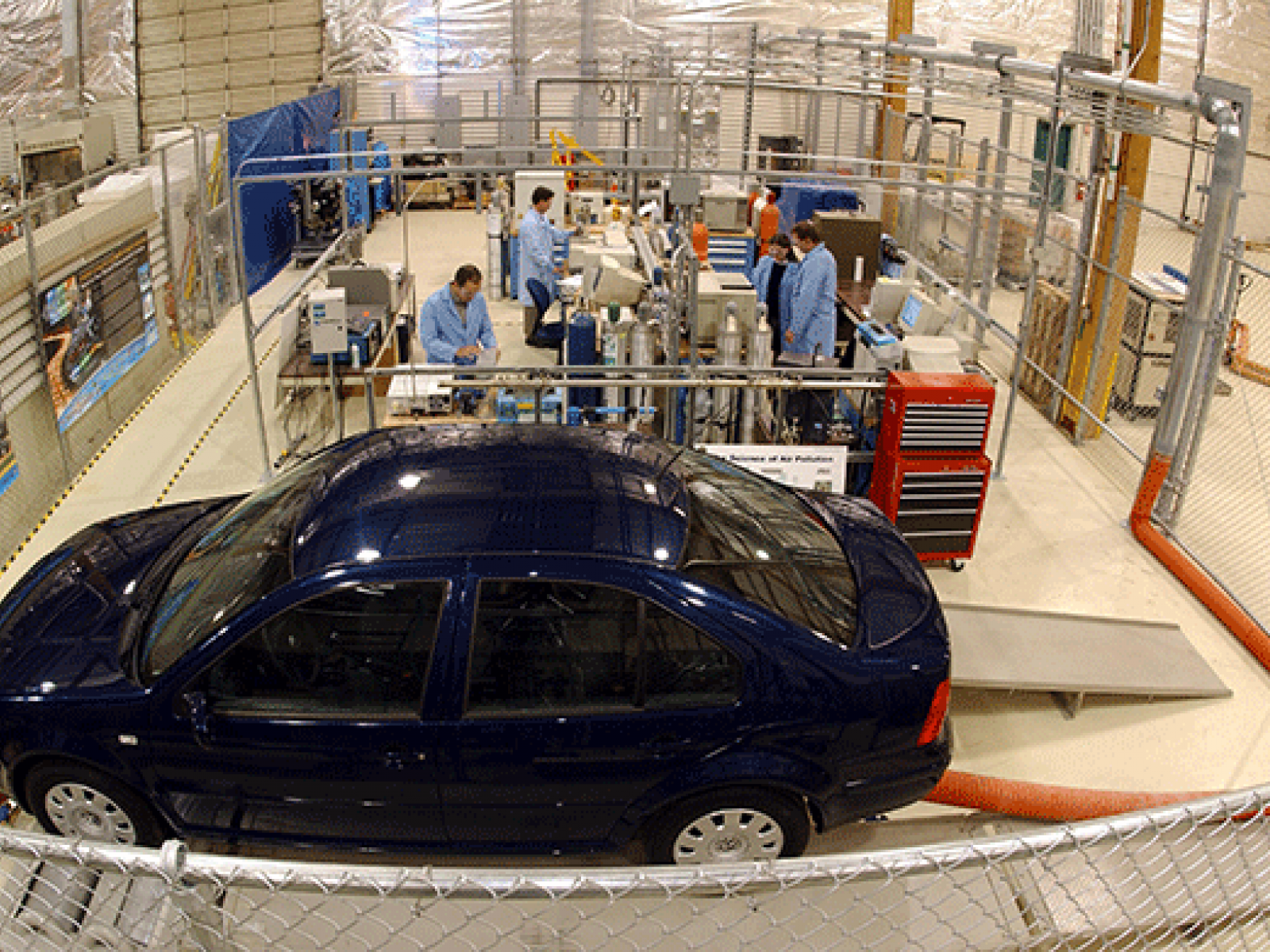PNNL Making Cleaner and More Efficient Vehicles

Researchers in PNNL's Engine Emissions Laboratory investigate catalysts, particulate traps and other methods for reducing diesel engine emissions.
(Photo by Pacific Northwest National Laboratory)
As Tri-Citians, we're fortunate that we don't have the frustrating traffic and long commutes that our friends in Seattle and Portland endure. And with lower prices at the pump, we don't think much about fuel efficiency.
However, across the nation, more than 25 percent of all energy use is for transportation—and our automobiles and light trucks use more than heavy-duty vehicles, air, marine and rail combined.
Since the vast majority of our transportation fuels are fossil-based, the environmental impact is significant. Reducing our consumption can help both our pocketbooks and the planet.
Researchers at the Department of Energy's Pacific Northwest National Laboratory have been working with industry on technologies for cleaner and more fuel-efficient vehicles for decades. Our efforts to advance lightweight materials, reduce emissions, improve synthetic lubricants and develop better electric vehicle technologies look beyond the laboratory toward industrial applications and widespread use.
PNNL is applying its engineering know-how to develop lighter materials for use in automobile manufacturing. Some of our developments are already on the road. For example, lightweight materials processes developed by PNNL have been incorporated into some models of the Cadillac STS and Chevy Malibu Maxx.
In more recent work, PNNL and several companies partnered to develop a new welding process to expand the use of lightweight aluminum in cars and trucks at the speed, scale, quality and consistency that industry demands. Friction stir welding can now be used to join aluminum sheets of varying thicknesses, making it possible to make parts that are lighter yet retain the required strength. The team delivered a car door 62 percent lighter and 25 percent less expensive than one made using traditional manufacturing methods. TWB Company has since incorporated this process into its production facility in Monroe, Mich., and can produce up to 250,000 parts per year.
In recognition of our leadership in this area, DOE asked PNNL to support its newly formed Lightweight Materials Multi-Lab Consortium. PNNL will serve as a matchmaker in this program—helping to connect the lightweight materials capabilities of participating laboratories with specific industry needs.
A second area of research draws upon PNNL's world-leading chemistry expertise to develop more efficient and cost-effective systems to reduce emissions. While lean gasoline and diesel engines may offer higher efficiency, there are challenges associated with meeting current and future emissions regulations, including oxides of nitrogen, a key contributor to smog and acid rain.
About a decade ago, PNNL's fundamental catalyst research with engine manufacturer Cummins Inc. and Johnson Matthey led to improvements in catalytic converters first used in the 2007 Dodge Ram. That technology resulted in a much more efficient diesel engine that met 2010 emission regulations three years early.
In current research, PNNL scientists are exploring selective catalyst reduction systems, where ammonia is used to reduce nitrogen oxide to elemental nitrogen. Our chemists and materials scientists are studying ammonia transport materials, basing their efforts on industry-defined metrics concerning performance, volume, weight and cost.
In a different application of our chemistry prowess, PNNL is contributing to tribology—the science of lubricants, wear and friction—which also is important to improving fuel efficiency. For example, our researchers are working on challenges associated with synthetic engine oils. While those with lower viscosity can achieve greater fuel efficiency, they can get so thin at higher temperatures that they don't protect surfaces from excessive wear. Our scientists have been studying how polymer-based additives that expand with heat can help offset the oil's thinning.
Finally, PNNL researchers are exploring ways to improve electric and hybrid vehicles. PNNL is developing new manufacturing methods in collaboration with U.S. automakers that allow more copper to be used in drive motors. The methods involve solid state material processing technologies that can deliver low-cost joints and fabrications with very high electrical conductivity, leading to potential efficiency increases of up to 25 percent over conventional motor designs.
PNNL researchers are developing better batteries so electric vehicles can travel farther between charges. These batteries offer the promise of holding as much as four times more energy per mass than today's lithium-ion batteries. Unfortunately, they cannot be charged as many times and have a much shorter lifespan. Our researchers are working to overcome these limitations. One study looked at using a unique nickel-based nanomaterial to capture the molecules that can cause the battery to fail after a few charges. We collaborate on several other battery projects as part of a national consortium for energy storage.
I've highlighted some of the ways PNNL researchers are helping to make cars and trucks that are easier on the pocketbook and friendlier to the planet. By working on lightweight materials and manufacturing processes, cleaner emission technologies, synthetic lubricants, and better electric motors and batteries, they are paving the way to the cheaper and cleaner vehicles of the future.
Steven Ashby, director of Pacific Northwest National Laboratory, writes this column monthly. To read previous Director's Columns, visit pnnl.gov/news and filter by Director's Columns in our Latest Stories.
Published: January 18, 2016